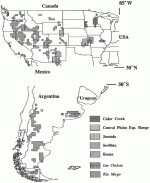To what degree are long-term sites in the grassland regions of both continents similar?
Unraveling basic ecological principles and solving urgent applied problems such as the evaluation of the effects of global change on ecosystems will require a diversity of approaches including monitoring, experiments, and simulation modeling. A comparative approach to these kinds of investigations may prove to be a very powerful tool. The LTER site network provides many opportunities to conduct comparative investigations both within the network and with other long-term research sites and networks.
The temperate zones of North and South America contain substantial areas of grasslands and offer many opportunities for comparative research. Why is it important to have similar sites on different continents? Some of the value derives from having sites with similar floras and faunas that have been subject to different evolutionary histories over .the past 10,000 years.
Additionally, recent (in the past 100 years) and current land use, as well as the predicted rate of climate change, are different in the grassland regions of North and South America. Using a comparative approach, ecologists can begin to test the generality of our understanding of particular ecosystems.
Our overall objective is to quantify the degree of similarity of the two grassland regions. The specific objective for this short article is to determine the degree to which long-term sites in the grassland regions of both continents are climatically similar. Using a global climatic data base developed by Leemans and Cramer, multivariate statistics, and image analysis software, we investigated the following specific question: To which portions of the two continents is each long-term research site most similar? The variables used in the comparison were mean annual temperature, mean annual precipitation, and seasonality of annual precipitation. The resolution of the analysis was 0.5 for both latitude and longitude.
The grassland LTER sites are poorly represented in South America but are representative of relatively large areas in North America (see figure). Only Konza and Jornada have climatic analogs in South America. By contrast, two long-term sites in South America are well represented in terms of North American climates. Las Chilcas is a tallgrass site in the Pampas region and is similar to Konza and some of the wetter parts of the tallgrass prairie in Kansas and Missouri. Rio Mayo is a shrub steppe site in Patagonia and is very well represented in the Great Basin region of the United States. Although there is remarkable similarity within the grassland and shrubland regions of North and South America, there are also interesting climatic differences. These differences are related to differences in the shapes and sizes of the temperate zones of the two continents.
W.K. Lauenroth, J.M. Paruelo, H.E. Epstein, I.C. Burke, M.R. Aguiar and O.E. Sala
Central Plains Experimental Range LTER and University of Buenos Aires, Argentina

 Enlarge this image
Enlarge this image